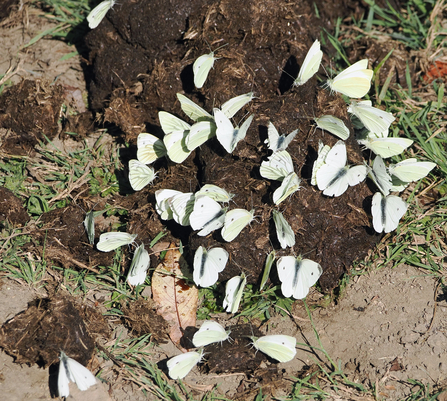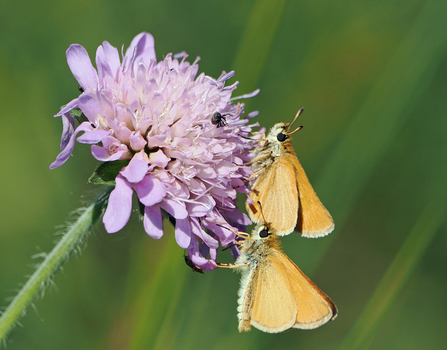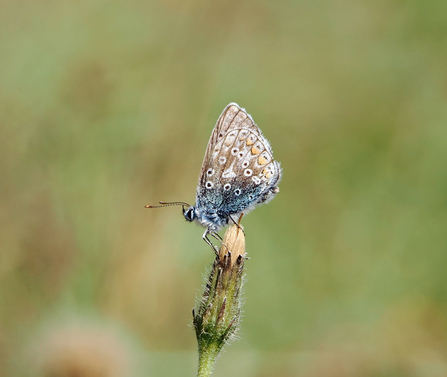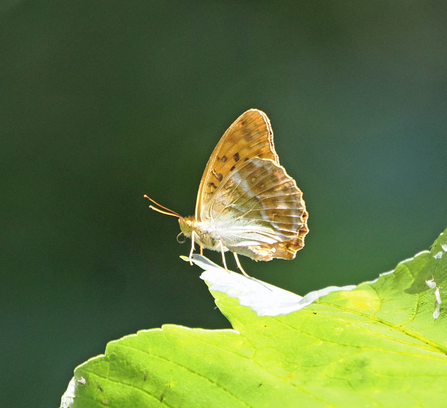
Green-veined white butterflies (C) Rod Jones
Wildflowers at Brockadale (C) Rod Jones

Green-veined white butterflies (C) Rod Jones
I’ve come across this bizarre banquet on a footpath through the ancient woodland at Brockadale Nature Reserve near Pontefract. Apparently, butterflies eat dung because it provides them with nutrients like sodium and nitrogen.
A five-minute walk from the shady woodland, I enter a completely different environment – a grassy meadow on a steep slope that’s bathed in sunlight on the hottest day of the summer so far. There are wildflowers everywhere, sporting brilliant colours and evocative names: purple clustered bellflower, yellow lady’s bedstraw, pink common restharrow.
This rare magnesian limestone grassland, which has never been ploughed or fertilised, helps make Brockadale one of the best places in Yorkshire to see butterflies, with 30 different kinds found here. It doesn’t take me long to spot the reserve’s poster species, the strikingly beautiful marbled white.
Marbled white butterfly (C) Rod Jones
It’s feeding on one of its favourite flowers, a purple field scabious, its gorgeously patterned black and white wings raised to catch a ray of sunlight. These spectacular butterflies have moved north into Yorkshire over the past 20 years, and there are now hundreds of them at Brockadale.
The field scabious flowers attract another, less flamboyant butterfly that’s made a similar shift from the south: Essex skippers have huge brown eyes and tiny wings that remind me of slightly faded, orange curtains.

Essex skipper butterflies (C) Rod Jones
Brockadale is also home to 450 different kinds of moths. Many are hard to find, but the six-spot burnet is a glorious exception. There are lots of them buzzing ponderously round the sunny meadow with curved bodies and crimson wings, like rudimentary flying machines that are just about managing to stay airborne.
It’s hard to take my eyes off the showy marbled whites and burnets, but when I look closer to the ground, there’s a flash of brilliant blue. One of my favourite butterflies – a common blue – is flitting among the delicate, yellow bird’s-foot-trefoil flowers.

Common blue butterfly (C) Rod Jones
When it comes to rest, I can appreciate the beauty of its underwings – a dainty pattern of brown, orange, black and white, fringed with blue – and marvel at its eyes, which look as if it’s wearing a tiny pair of sunglasses.
As I wander alongside the River Went, which flows through the reserve, I’m reminded that there are birds here too. There’s a rustling noise, followed by a flap of wings. A female sparrowhawk bursts out of her hiding place among shady branches a few metres away from me and flies off. Seconds later, I hear a chiffchaff calling in the nearby trees: maybe I’ve unwittingly saved this little warbler from an expert ambush predator.
There’s more birdsong when I climb up the footpath to the top of the meadow: a series of rasping notes, followed by a wheezing noise. It’s coming from the hedgerow, and it’s the song of a yellowhammer. Bird guides describe it as sounding like “little bit of bread and no cheese,” although to my ear the syllables don’t quite fit.
Yellowhammers are another of Brockadale’s star species – finches whose numbers across the UK have fallen by around 30 per cent over the past 30 years. I’m keen to see one, but it proves surprisingly difficult to spot a bright yellow bird in a hedgerow. While I’m searching, I find another fascinating species of butterfly…
White-letter hairstreak butterfly (C) Rod Jones
The white-letter hairstreak is named after the W-shaped streak etched in white on its brown underwings. I’m lucky to see this one resting among the shady leaves at head height: these butterflies spend most of their time out of sight, flying around the treetops.
Meanwhile, more yellowhammers join in the hedgerow chorus – but they remain, disappointingly, heard but not seen…
By early afternoon, the temperature has soared beyond 30°C. While many butterflies revel in hot and sunny conditions like these, other animals find them tough.
An oak tree provides a small patch of shade from the sweltering heat of the meadow. As I walk towards it, I spot a mistle thrush perching under a natural shelter of green leaves. Its beak is open, but there’s no sound coming out: this bird isn’t singing; it’s panting.

Mistle thrush (C) Rod Jones
Birds can’t sweat, so – like dogs – they pant instead. Opening their beaks and breathing heavily allows air to rush in, causing the moisture in their lungs, throat and mouth to evaporate. This absorbs heat and helps keep them cool.
It’s a reminder that, as the scorching sun reaches its zenith, I need to get away from the open meadows and take refuge in Brockadale’s woodlands.
It’s far cooler and darker here, but I come to a sunny glade where shafts of light break through the tree canopy. When I look up, something catches my eye – a large butterfly resting on a sycamore leaf a few metres above the path.

Silver-washed fritillary butterfly (C) Rod Jones
Its wings are pointed and orange with black dots, and there’s a silvery sheen on its underwings that gives it its name: silver-washed fritillary.
After I’ve taken a few photos, it flies off on powerful wingbeats. But seconds later, I spot it again.
This time, it’s joined by another one, and the pair chase each other round the glade, swooping and whirling just above my head, before spiralling away and vanishing into the sunlight.
A magical dance to end a day of spectacular performances by Brockadale’s butterflies.